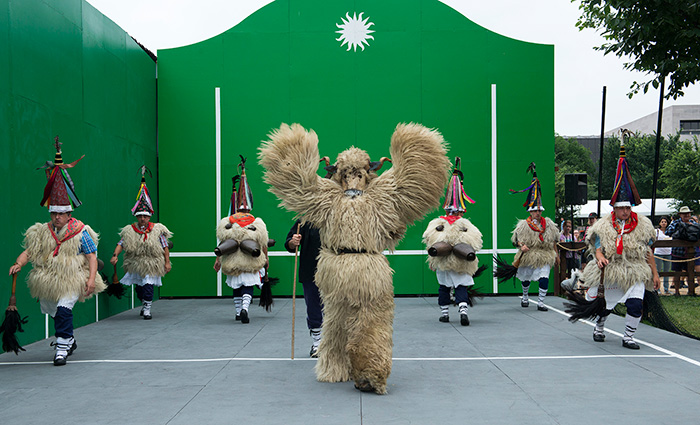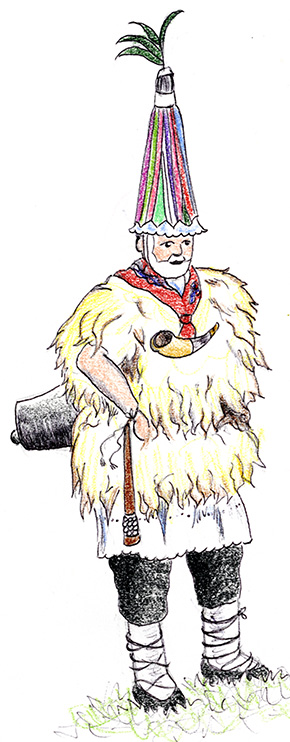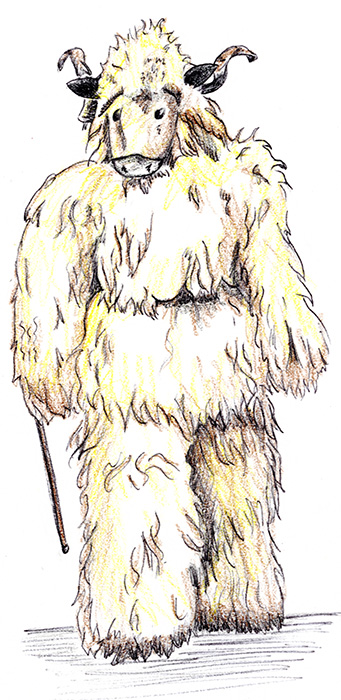The Joaldunak from Head to Toe

Their rhythmic ringing can be heard across the Folklife Festival, and their elaborate dress attracts every smartphone camera. These are the Joaldunak, a Basque procession group that literally translates to “people with bells.”
The group has mysterious origins. Even anthropologists haven’t been able to figure out when this peculiar tradition began. But here is what we know: each year in the last week of January, up to sixty men (and now women) march from one small village to another, with clanging bells strapped on their backs, marking the arrival of carnaval as a pre-Christian pagan ritual. Together they represent a flock of sheep, and at the center of their parade is a sheepherder handling a bear (artza) to scare away the wolves.
The whole outfit weights about thirty-three pounds. Lazaro Erreguerena, one of the elders of the group who learned the tradition from his parents and grandparents, explained each element of their dress.

Hat
Each dancer makes their own elaborate conical hat, called ttuntturrua, topped with rooster feathers and decorated with colorful ribbons. Connecting the feathers to the rest of the hat is a piece of cloth traditionally torn from the outfit of a priest—remember, this is a pagan tradition. Lazaro also pasted on a small Basque flag.
Scarf
Traditionally, men borrowed whatever scarves they could from their wives. But starting about fifty years ago, when Joaldunak began performing in other towns and provinces, they unified their dress with matching scarves.
Horn
Lazaro plays a turuta bull horn that he wears around his neck. When dancers start getting tired and their bells quiet down, he blows the horn to liven them up again.
Sheep Wool
The bulk of the dress is called artilia, the wool of two Latxa rams. Since the procession is usually held in late January, the wool keeps out the winter chill. In Washington, D.C., in July, however, the wool suits keep the dancers a little too toasty; they usually break mid-procession for a beer.
Horsetail Whip
Each carries an isopoa, a sort of whip topped with a horsetail. The whips are handmade by the dancers, personalized with their names carved into the wooden handles. They are remnants of an older era when horses were also used to scare away wolves, in the same way the bear acts now.
Bells
Each dancer wears four bells called joaria strapped onto their backs. The two big ones produce sound, while the small ones at their shoulders are just for decoration. Weighing eleven pounds each, the big bells require two other people to help secure them onto the back of one dancer.
Under Skirt
The azpiko gona is worn under the artilia and on top of the pants, representing female identity as a contestation of the church. Women are regarded equally; as of about fifty years ago, women have been participating in the procession alongside the men, in the same costumes.
Pants and Footwear
The maon pants are always blue, and they represent the traditional peasant dress in the northern Nafarroa region. Like traditional Basque dancers, the Joaldunak wear albarkak leather shoes laced up over white zapinak socks. The shoes must be sturdy enough to march the 2.2 miles from Ituren to Zubieta.

The Bear
This mythological bear character also wears sheepskins, along with a set of ram horns. He marches along with the sheep to scare away predators, like wolves.
“Now they use it to scare the wolves around here: the people,” explained presenter Idoia Ariceta Lopez.
Indeed, as the group marches down the National Mall, the artza charges at visitors (usually ones filming on their phones) before being pulled back into the flock by the sheepherder.
Any member of the group can choose to be the artza. They only need to prove that they have the energy and stamina to move quickly in a full suit of wool.
The Joaldunak have returned to the Basque country, but stay tuned on the Festival Blog for videos of their performances.
Elisa Hough is the editor for the Center for Folklife and Cultural Heritage. Dulcia Halliday is a graphic design intern for the Folklife Festival; she studies graphic design at SUNY New Paltz.
Participation of the Joaldunak was made possible by the Government of Navarra.

